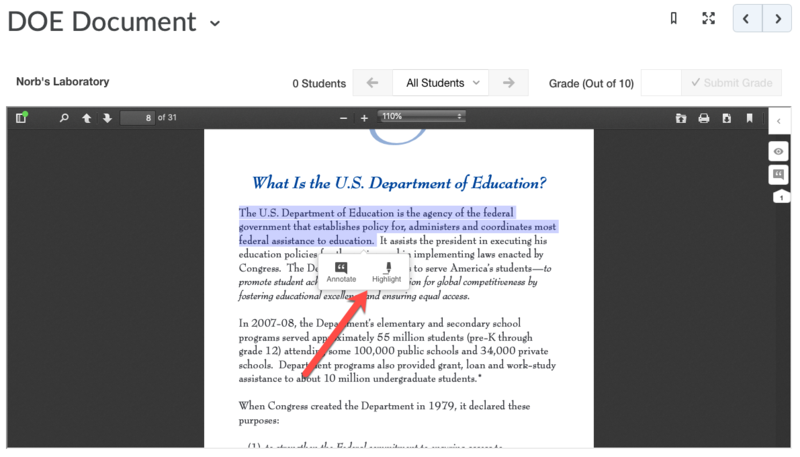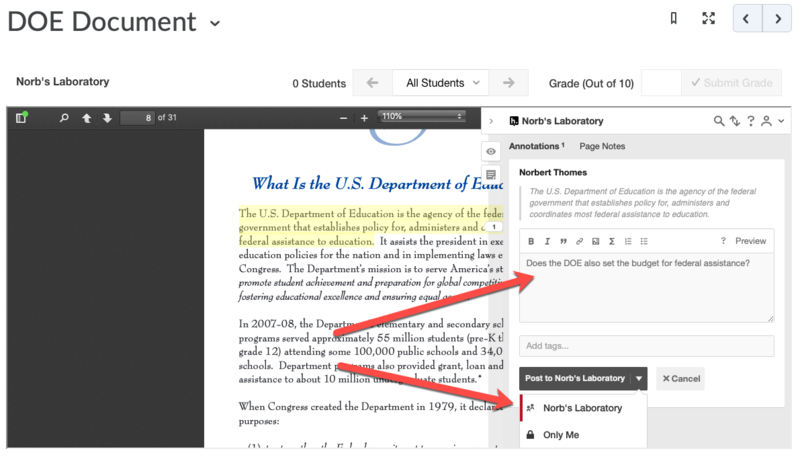Using Hypothes.is to annotate in your Brightspace course
About This Article
This article describes how to integrate the annotation tool Hypothes.is into your Brightspace course. It is intended for instructors using Brightspace or those interested in using Brightspace in the future.
What Hypothes.is does
From the Hypothes.is web site: Writing in the margins has always been an essential activity for students. Annotation helps in reading comprehension and in developing critical thinking about course materials. Hypothesis enables students to continue this essential activity with online readings. Digital annotation also offers new affordances, enabling students to respond to text using different media and empowering them to collaborate on understanding and developing ideas about their readings. Hypothesis makes reading visible, active, and social.
Integrating Hypothes.is into your course
- Within your D2L Brightspace course, navigate to Materials and then to Content. Go to the module into which the document is to be added.
- Within that module, click Existing Activities and then External Learning Tools.
- Scroll to the bottom of the window and click Create New LTI Link. This will ultimately create a new topic in your module.
- Enter a Title for the topic and copy/paste the following link into the LTI URL field: https://lms.hypothes.is/lti_launches. You will have to click or tab off the URL field after the paste operation. This will turn the Tool field to Hypothesis.
- Click Create and Insert.
- Click on the name of the newly created topic in the Content area of your course. The Assignment details screen will be displayed
- Supply the document to be annotated and then click Submit. There are three document options supported by Hyporths.is within Brightspace:
- Supply the URL of a live webpage.
- Supply the URL of a PDF file on the web.
- Select a PDF from Google Drive or OneDrive. A copy of the PDF will be uploaded to your course and made available for annotation.
- Follow the instructions for the type of document you are presenting for annotation.
Once this operation is complete, clicking the topic in the course will go directly to the document to be annotated.
Using Hypothes.is to annotate
Hypothes.is will display the document in the window. To annotate the document, follow these steps:
- Using your mouse, hold down the left button and drag a selection over the text you wish to annotate or highlight.
- Select Annotate or Highlight from the popup. See below.

- Selecting Annotate will cause the text to be highlighted and the annotation fly-out to appear. See below.
- Selecting Highlight will cause the text to be highlighted only. If you wish to annotate the text after highlighting, click on the highlighted text and the annotation fly-out will be displayed. You will have to click the pencil icon to add an annotation.

- The example above shows the annotation fly-out pane. Enter the comments and questions in the text editor, click the down arrow at the right end of the post-selection box at the bottom left, select whether this is to be posted publicly (to the class) or privately (for the author only), and click the post-selection button to post.
Account creation and sharing annotations
From Hypothes.is Support: When the Hypothesis LMS app is installed in a course site, the app will automatically create a private group for that course. The app will also provision accounts for all students and instructors in the course site when they launch the app for the first time. This means that students can begin annotating readings in the LMS without creating or logging into a separate Hypothesis account, and they won’t need to worry about switching away from the Public layer.
These LMS-based Hypothesis accounts operate differently than public Hypothesis accounts in the following ways:
- They are domain-specific: They only work within the LMS instance in which they were created, not on the open web.
- They are separate from regular Hypothesis accounts: Users who have created accounts through the public Hypothesis service will be given new and separate accounts for use within the context of the LMS.
- They cannot create their own private groups: A private group is automatically generated for courses where the Hypothesis LMS app is installed. Neither instructors nor students will be able to create additional private groups within the LMS context.
- They do not have access to Hypothesis profile and group activity pages: This is something we plan to address in the near future so that teachers and students can view their annotated comments and conversations outside of the context of a particular document.
Assessing student annotations
You can assess the student's work directly in the Hypothes.is window. Scores given in Hypothes.is are ported directly into the Brightspace grade book.
There are full instructions on assessing student annotations on the Hypothes.is Support Page.
More Information
Minnesota State Knowledge Article: Hypothes.is Integration (KA# 2113)
Related Wiki Topics
- Adding a OneNote Class Notebook to a Brightspace course
- First Day
- Using Cengage WebAssign in your Brightspace courses
- Using LinkedIn Learning in your Brightspace course
- Create Microsoft Teams meeting in a Brightspace Course
- Adding RedShelf content
- Third-party application integration in Brightspace
- Integrating publisher-provided content into Brightspace
- Using Tevera to record field work
- Using Hypothes.is to annotate in your Brightspace course
For a complete listing of topics, select from the category list below.